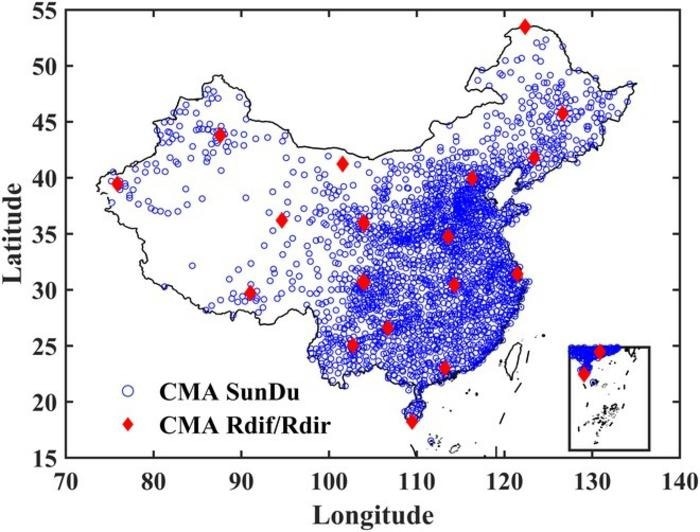Reviewed by Lexie CornerMar 18 2024
Researchers have developed a groundbreaking machine learning technique to estimate solar radiation components in China, eliminating the necessity for local ground truth data.
 Spatial distribution of CMA stations. A total of 2,453 blue circles represent routine weather stations, which have sunshine duration measurements. Seventeen red rhombuses represent radiation stations that have Rdir and Rdif observations. Image Credit: Journal of Remote Sensing
Spatial distribution of CMA stations. A total of 2,453 blue circles represent routine weather stations, which have sunshine duration measurements. Seventeen red rhombuses represent radiation stations that have Rdir and Rdif observations. Image Credit: Journal of Remote Sensing
This discovery solves the need for more radiation component data and creates new opportunities for the solar energy sector.
In a recent study, researchers estimated diffuse and direct solar radiation using data augmentation in conjunction with the LightGBM machine learning model, published in the Journal of Remote Sensing in February 2024. The limitations of sparse and unevenly distributed ground-based observations are overcome in this research by utilizing sunshine duration data gathered from over 2,453 weather stations across China.
This method cleverly avoids the conventional challenges of sparse and unevenly distributed ground-based observations by leveraging sunshine duration data collected from over 2,453 weather stations.
The main contribution of this work is the innovative use of machine learning algorithms to predict solar radiation components with previously unheard-of accuracy.
These algorithms are trained on augmented datasets. It is especially revolutionary because the methodology is globally applicable and does not depend on local ground truth data for calibration.
The efficacy of this model was validated in China, and its potential for global application was suggested by its validation against independent datasets. This study's production of a brand-new satellite-based dataset stands out for its increased accuracy over pre-existing datasets, offering a thorough spatial distribution of the components of solar radiation. This dataset provides insights that can result in more effective and optimized solar energy production, which is crucial for furthering solar energy research and deployment.
Our method significantly enhances the accuracy and applicability of solar radiation component estimates, paving the way for optimized solar energy utilization across China and potentially worldwide.
Kun Yang, Professor and Lead Researcher, Tsinghua University
This novel method not only sets a new benchmark for solar radiation estimation but also offers a globally scalable solution, indicating a revolutionary change in the study and application of solar energy.
The recently created satellite-based dataset provides a comprehensive spatial analysis of solar radiation components and outperforms earlier datasets in terms of precision. This development is critical to the solar energy industry because it makes it possible to strategically choose sites and optimize systems, particularly in regions with significant solar energy potential.
Journal Reference:
Shao, C., et al. (2024) Data Augmentation-Based Estimation of Solar Radiation Components without Referring to Local Ground Truth in China. Journal of Remote Sensing. doi.org/10.34133/remotesensing.0111